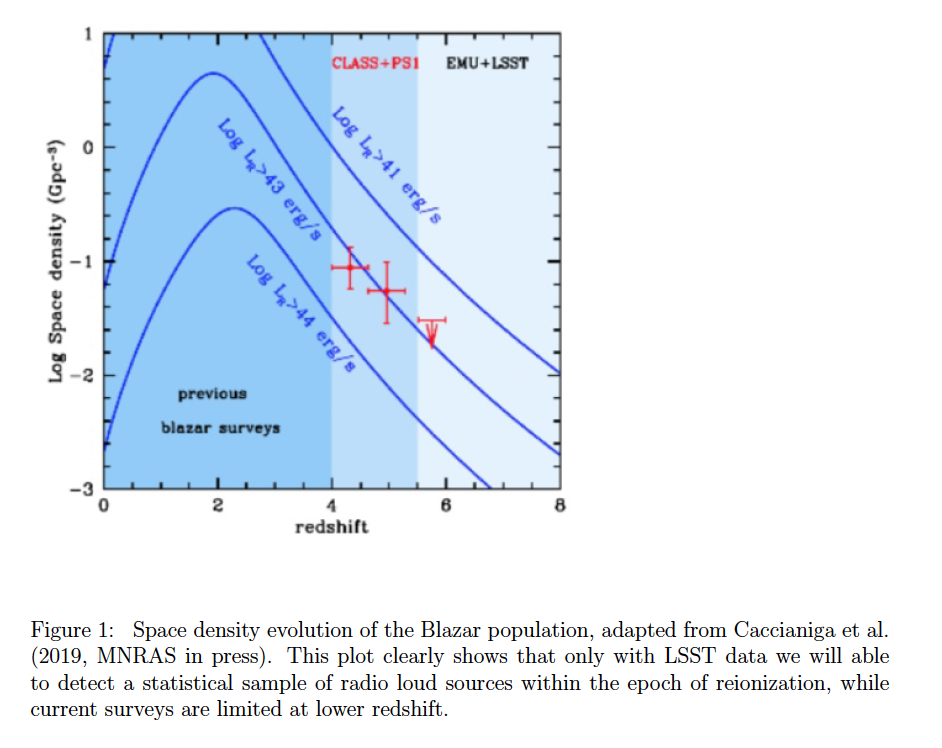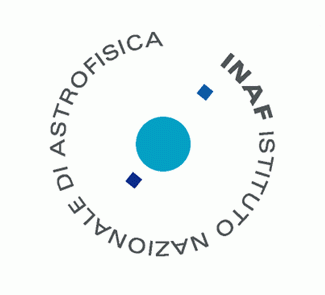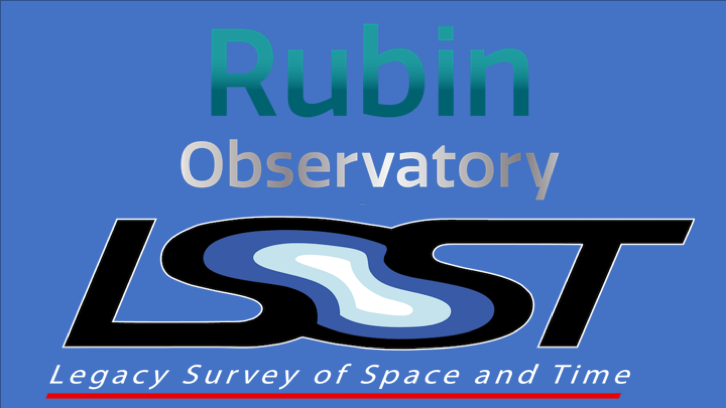Scientific Objectives
The purpose of our project is to use the unique combination of wide and deep imaging from LSST to study AGN and galaxy populations at high redshift (4<z<7.5). The main goals will be to critically assess the role of AGN and galaxies in driving the reionization process in the early Universe, to improve our understanding of the growth of SMBHs and the stellar mass assembly in galaxies. AGN and galaxy candidates at z>4 will be selected by combining several techniques: color-color selection, photometric redshifts, morphology, variability, lack of proper motion and by cross-correlating LSST data with Radio (FIRST, CLASS, ASKAP), X-ray (eRosita) and InfraRed (FLAMEX, UKIDSS, VISTA, WISE, Euclid) surveys. Moreover, spectroscopic follow-up for a great fraction of the high-z sources to conform the redshift will be possible with VLT-MOONS, VISTA-4MOST, and Subaru-PFS; together with dedicated follow-up of the interesting targets with TNG, LBT, VLT, ALMA.
During 2018, Emiliano and Valerio kept being in the “Galaxies” Working Group. Angela took part in the definition of the survey strategy and contribute to the DDF Cadence White Paper (Brandt et al, 2018, arXiv:1811.06542). The LSST related activities have been focused on performing some tests on the Subaru HyperSuprimeCam COSMOS data applying template-fitting technique (TPHOT, Merlin et al., 2015,2016) in order to extract photometry using HST images as prior. This work is still in progress and the goal is to compare the photometry extracted in this way with the results of the official LSST/HSC pipeline. The plan for 2019 is to include this exercise in a wider context. In particular, we plan to create dedicated imaging simulations, including both galaxies and AGN, on which we will perform extended tests exploiting different photometric techniques (aperture vs template fitting vs PSF-modeling). The result of the test should tell us at which extent the use of a high resolution prior (e.g. Euclid VIS images) might improve the photometric accuracy of LSST data. The simulated catalog will also be used to fine-tune selection methods to identify high-z galaxies and AGN.
In the meanwhile as preparatory science activity we are making use of the available optical, near-IR and radio catalog to study the high-z radio loud population. We focus on radio loud QSOs for several reasons. First, radio loud QSOs allow us to probe a portion of the QSO color plane that has never been explored before. Then radio-loud sources are extremely valuable probes of the physical state of the very early inter- galactic medium (IGM) up to very high redshift (e.g. Furlanetto 2006, Phys. Rep., 433, 181). Finally the study of the radio-loud fraction redshift evolution might provide some important piece of information on the accretion mode, the mass an the spin of the SMBH (e.g. Kellerman et al. 2106, 831, 168). In 2018 we actively worked to the selection of a radio-loud AGN sample in the still unexplored redshift bin 5.5-6.5. We obtained deep photometry for a list of 50 candidates at 3.6 m telescope (TNG and NTT, Belladitta and Caccianiga observers) in 8 nights, selecting a list of 15 objects which have been proposed (and accepted) for spectroscopic follow-up to LBT . Observations are ongoing.
We also focussed on the particular class of Blazar which are radio-loud AGN whose relativistic jet is pointing towards Earth. From the study of these objects we can infer global properties, like SMBH space density in jetted AGN, without the bias due to absorption . In 2018 we concluded the selection of the first statistical sample of z> 4 Blazar from CLASS survey: these are 24 objects over a solid angle of 16,300 deg2. With this sample, for the rst time, we estimated the Blazar space density at high redshift (Caccianiga et al. 2019 MNRAS in press). Our study clearly shows that, while the number of detectable Blazars within the epoch of re-ionization (z> 6) with the currently available surveys is almost negligible (< 3 all over the sky), LSST will allow to observe a statistical sample of this extremely important population

Members
Principal Investigator:
Angela Bongiorno, INAF-Osservatorio Astronomico di Roma
Co-Investigator:
Andrea Grazian INAF-Osservatorio Astronomico di Roma
Alessandro Caccianiga INAF-Osservatorio Astronomico di Brera
Alberto Moretti INAF-Osservatorio Astronomico di Brera
LSST young researchers:
Emiliano Merlin INAF-Osservatorio Astronomico di Roma
Alberto Moretti INAF-Osservatorio Astronomico di Brera
Andrea Grazian INAF-Osservatorio Astronomico di Roma
Silvia Belladitta INAF-Osservattorio Astronomico di Brera
Other INAF participants:
Claudia Cicone INAF-Osservatorio Astronomico di Brera
Marco Landoni INAF-Osservatorio Astronomico di Brera
Marianna Torelli INAF-Osservatorio Astronomico di Roma
L. A. Antonelli INAF-Osservatorio Astronomico di Roma
S. Cristiani INAF-Osservatorio Astronomico di Trieste
R. Della Ceca INAF-Osservatorio Astronomico di Brera
F. Fiore INAF-Osservatorio Astronomico di Roma
F. Fontanot INAF-Osservatorio Astronomico di Trieste
G. Ghisellini INAF-Osservatorio Astronomico di Brera
E. Giallongo INAF-Osservatorio Astronomico di Roma
F. Haardt Università d’Insubria
F. La Franca Università di Roma
M. Magliocchetti INAF-Istituto di Astrofisica e Plantetologia Spaziale di Roma
N. Menci INAF-Osservatorio Astronomico di Roma
L. Pentericci INAF-Osservatorio Astronomico di Roma
E. Piconcelli INAF-Osservatorio Astronomico di Roma
G. Polenta ASDC
R. Salvaterra INAF-Osservatorio Astronomico di Brera
R. Scaramella INAF-Osservatorio Astronomico di Roma
R. Schneider Università di Roma
P. Severgnini INAF-Osservatorio Astronomico di Brera
E. Vanzella INAF-Osservatorio Astronomico di Bologna
G. Zamorani INAF-Osservatorio Astronomico di Bologna
LSST Affiliation
Galaxies
AGN
Activity Report

